Special Report
Counties With the Worst Drug Problem in Every State

Published:
Last Updated:

The U.S. has experienced a massive surge in drug addiction, and consequently fatal overdoses, in recent years. In 1999, the National Institute on Drug Abuse reported an age-adjusted rate of 6.1 fatal overdoses per 100,000 Americans. By 2019, that figure had more than tripled to 21.6 fatal drug overdoses per 100,000 people.
While this problem has affected every part of the country, certain areas struggle with an outsized share of drug overdose deaths. There are dozens of counties and county equivalents in which drug overdose deaths are more than twice as common as they are nationwide. Each state has one place where the drug overdose problem stands out as especially severe.
To determine the county with the worst drug problem in every state, 24/7 Tempo reviewed the annual average number of drug-related deaths per 100,000 residents in all U.S. counties and county equivalents from 2015 to 2019, using data from the Centers for Disease Control and Prevention.
Addiction and drug use are complicated and multifaceted issues that touch Americans nationwide and at all socioeconomic levels. Still, the counties that have the worst drug problems tend to have certain characteristics in common, including relatively lower income, higher unemployment, and higher poverty. This is the poorest county in every state.
Rural areas like those in the Rust Belt and the Appalachian region have become the face of the opioid epidemic — but this was not always the case. Until recently, drug problems were largely seen as a problem plaguing cities. Only in 2015 did drug overdose deaths become more common in rural areas than in cities.
As Americans have looked for answers as to how the drug problem in the country has gotten so severe, much of the blame has been placed on large pharmaceutical companies — particularly Purdue Pharma. The company began selling the painkiller OxyContin in 1996. Since then, the company has paid over $10 billion to settle a litany of lawsuits that claimed Purdue deceived patients and doctors about the risks of becoming addicted to the drug when advertising it. These are America’s most hated companies.
Click here to see the counties with the worst drug problem in every state.
To determine the counties with the worst drug problem in every state, 24/7 Tempo reviewed the average number of drug-related deaths per 100,000 residents in all U.S. counties and county equivalents each year for the 2015 to 2019 period with data from the Centers for Disease Control and Prevention’s WONDER web application. The causes of drug-induced deaths include unintentional overdoses, suicide, homicide, and undetermined causes. Figures on poverty and population came from the U.S. Census Bureau’s American Community Survey and are five-year averages for the period of 2015 to 2019. All data is for the most recent period available.
Alabama: Jefferson County
> Annual drug deaths per 100,000 residents, 2015-2019: 38 (state: 18)
> Total drug-related deaths, 2015-2019: 1,249 — the most out of 67 counties (state: 4,426)
> Poverty rate: 16.0% — 50th highest out of 67 counties (state: 16.7%)
> Jefferson County population: 659,680
Jefferson County, Alabama, had an average of 38 annual overdose deaths per 100,000 people between 2015 and 2019, more than double the statewide rate of 18 overdose deaths per 100,000 people and the highest rate of all 67 counties in Alabama. Drug overdoses are mostly associated with poor regions, but drug use is growing in all parts of the U.S., affecting upper-income people as well. Heroin overdoses in particular have been on the rise among the wealthy.
In Jefferson County, Alabama, the median household income is $53,901 a year, one of the highest in the state, compared to a statewide median of $50,536.
[in-text-ad]

Alaska: Juneau Borough
> Annual drug deaths per 100,000 residents, 2015-2019: 28 (state: 19)
> Total drug-related deaths, 2015-2019: 45 — 5th most out of 29 counties (state: 691)
> Poverty rate: 7.7% — 24th highest out of 29 counties (state: 10.7%)
> Juneau Borough population: 32,227
Alaska’s capital city of Juneau, also known as Juneau Borough, is treated as a county equivalent by the U.S. Census. Juneau is an example of a relatively wealthy region having the worst drug problem in the state. On average, 28 residents per 100,000 a year have died from a drug overdose each year between 2015 and 2019, compared to a statewide rate of 19 per 100,000.
Alaska as a whole is among the states with the highest annual household income and lowest poverty rate. Residents in Juneau, specifically, are even better off than Alaskans overall. The median household income in Juneau is $88,390, the highest in the state and significantly higher than both the state and national median.

Arizona: Gila County
> Annual drug deaths per 100,000 residents, 2015-2019: 38 (state: 24)
> Total drug-related deaths, 2015-2019: 103 — 10th most out of 15 counties (state: 8,279)
> Poverty rate: 21.6% — 6th highest out of 15 counties (state: 15.1%)
> Gila County population: 53,546
Gila County had an average of 38 overdose deaths per 100,000 people each year between 2015 and 2019, the highest rate of all 15 counties in Arizona. Drug overdose deaths are often more common among poor Americans, who tend to lack the resources to seek substance addiction help and who live in communities that lack adequate funding for programs to fight the spread of drugs. More than one in five residents of Gila County live below the poverty line, a significantly higher rate than the statewide poverty rate of 15.1%.
Drug overdose is a leading cause of preventable death in the U.S. Gila County has the third highest premature mortality rate in the state at 558 deaths before the age of 75 per 100,000 residents annually.

Arkansas: Lincoln County
> Annual drug deaths per 100,000 residents, 2015-2019: 33 (state: 15)
> Total drug-related deaths, 2015-2019: 22 — 24th most out of 75 counties (state: 2,208)
> Poverty rate: 20.0% — 30th highest out of 75 counties (state: 17.0%)
> Lincoln County population: 13,455
Of the 75 counties in Arkansas, Lincoln has the highest age-adjusted rate of drug overdose deaths at 33 deaths per 100,000 residents, more than double the state rate.
Overdose death rates have increased significantly over the last two decades, with the toll highest among the least educated people. People with lower educational attainment tend to earn lower incomes than those with higher education. Only about 9.7% of Lincoln County residents have at least a bachelor’s degree, the second lowest share in the state and less than three times the national share of 32.1%.
[in-text-ad-2]

California: Lake County
> Annual drug deaths per 100,000 residents, 2015-2019: 56 (state: 14)
> Total drug-related deaths, 2015-2019: 180 — 31st most out of 58 counties (state: 27,860)
> Poverty rate: 18.6% — 16th highest out of 58 counties (state: 13.4%)
> Lake County population: 64,195
Lake County, located in north central California, not far from Sacramento, has the highest drug overdose death rate of all 58 state counties and one of the highest in the U.S. as a whole. There have been an average of 56 fatal overdoses a year between 2015 and 2019 per 100,000 residents, four times the state average of 14 per 100,000 people and more than double the national average of 21 per 100,000.
While drug overdoses in recent years have come to affect more people, including those who earn higher incomes, substance use disorder continues to disproportionately affect those living in poverty. The median household income in Lake County, California, is among the lowest in the state at $47,040 a year, compared to $75,235 a year across California as a whole.

Colorado: Huerfano County
> Annual drug deaths per 100,000 residents, 2015-2019: 59 (state: 18)
> Total drug-related deaths, 2015-2019: 20 — 25th most out of 64 counties (state: 5,072)
> Poverty rate: 15.8% — 16th highest out of 64 counties (state: 10.3%)
> Huerfano County population: 6,679
Huerfano County, Colorado, is south of Pueblo and just north of the state’s southern border with New Mexico. The area reported 59 drug deaths per 100,000 residents each year from 2015 to 2019, by far the highest rate of any county in the state and the 21st highest in the entire country. This is nearly triple the comparable nationwide drug death rate of 21 per 100,000.
Areas that struggle economically tend to have a higher incidence of drug overdose deaths. Huerfano County reported a median annual household income of less than $39,000, well below the Colorado median household income of $72,331.
[in-text-ad]

Connecticut: Windham County
> Annual drug deaths per 100,000 residents, 2015-2019: 38 (state: 30)
> Total drug-related deaths, 2015-2019: 221 — 7th most out of 8 counties (state: 5,295)
> Poverty rate: 11.4% — 2nd highest out of 8 counties (state: 9.9%)
> Windham County population: 116,566
All but one of the eight counties in Connecticut have an annual drug overdose death rate that is lower than the national rate of 21 deaths a year per 100,000 people. Many people who are addicted to drugs are also diagnosed with other mental disorders. The opposite is also true. Chronic use of some drugs can lead to mental health issues such as depression and anxiety. Adults in Windham County report an average of more mentally unhealthy days per month than residents of other counties.
Accidental drug overdose is currently among the leading causes of death for Americans under 50, according to the Drug Policy Alliance, a nonprofit advocating for drug policy reform. Windham County’s premature death rate is the highest in the state, with 337 deaths before the age of 75 per 100,000 residents. In comparison, the second highest premature death rate in Connecticut is 309 per 100,000 in New London County.
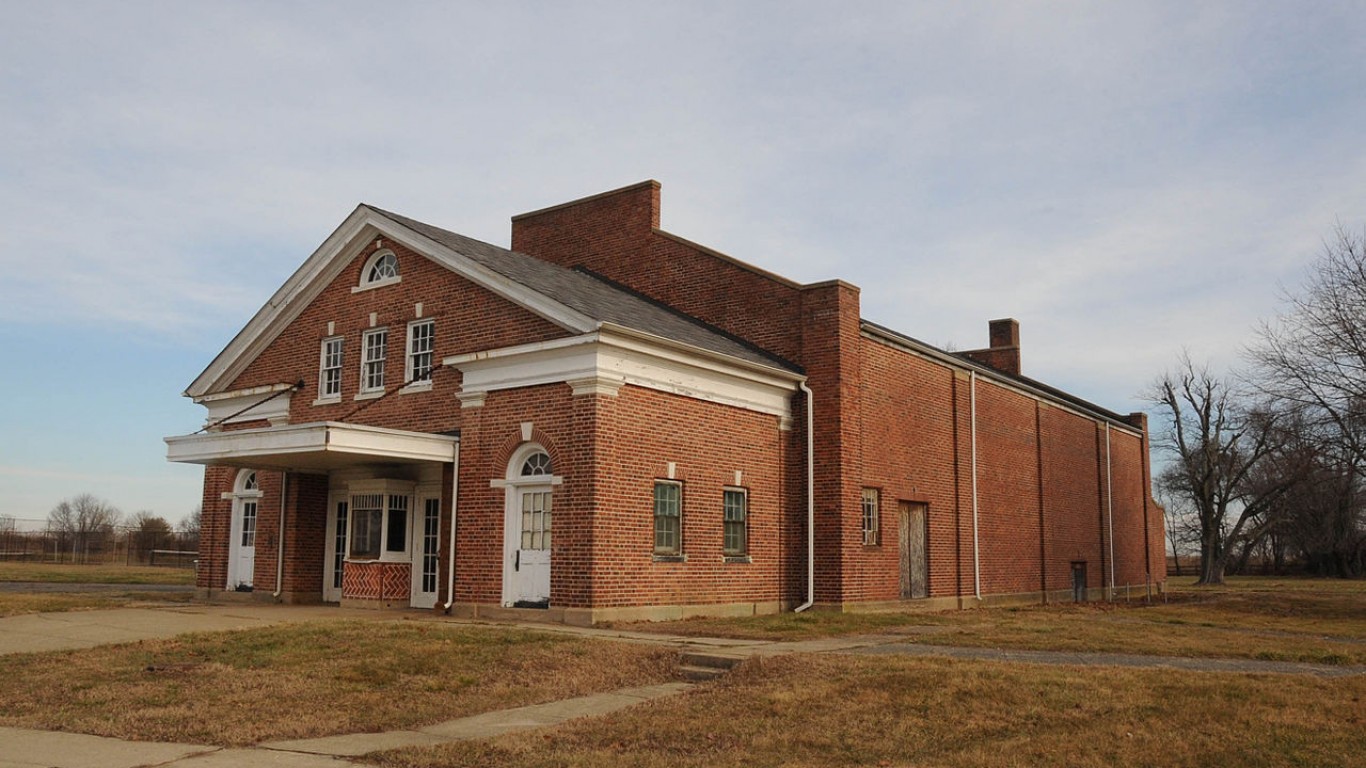
Delaware: New Castle County
> Annual drug deaths per 100,000 residents, 2015-2019: 37 (state: 35)
> Total drug-related deaths, 2015-2019: 1,045 — the most out of 3 counties (state: 1,689)
> Poverty rate: 11.4% — 2nd highest out of 3 counties (state: 11.8%)
> New Castle County population: 556,165
All three counties in Delaware have relatively high rates of annual drug deaths, but New Castle County has the highest rate at 37 drug deaths per 100,000 people. The county, which makes up the northern part of the state, is home to the majority of the state’s population.
Unlike nearly every other county with the worst drug problem in its state, New Castle County is relatively prosperous economically. Its November 2020 4.8% unemployment rate compares to a national 6.4% rate. It also has by far the highest median household income among Delaware counties at $73,892 — $11,000 higher than the U.S. median and $5,600 higher than the Delaware median.

Florida: Brevard County
> Annual drug deaths per 100,000 residents, 2015-2019: 40 (state: 23)
> Total drug-related deaths, 2015-2019: 1,188 — 8th most out of 67 counties (state: 24,153)
> Poverty rate: 11.8% — 53rd highest out of 67 counties (state: 14.0%)
> Brevard County population: 585,507
Of the 67 counties in Florida, Brevard has the highest rate of age-adjusted drug overdose deaths at 40 per 100,000 residents, nearly double the statewide rate of 23 overdose deaths per 100,000.
Florida performs similarly compared to the country as a whole in socioeconomic factors such as poverty and unemployment. Brevard County performs slightly better than the state as a whole. The annual household income in the county is $56,775 a year compared to the state median of $55,660, and the unemployment rate is 5.3%, compared to 6.3% across the state.
[in-text-ad-2]

Georgia: Haralson County
> Annual drug deaths per 100,000 residents, 2015-2019: 28 (state: 14)
> Total drug-related deaths, 2015-2019: 41 — 38th most out of 159 counties (state: 7,462)
> Poverty rate: 14.9% — 121st highest out of 159 counties (state: 15.1%)
> Haralson County population: 29,227
Haralson County is due west of Atlanta, along the Georgia border with Alabama. The area reported 28 drug deaths per 100,000 residents, double the annual rate of drug deaths in the state.
Drug overdoses are one of the leading causes of death for Americans under 50, and areas with higher addiction rates tend to have very high premature death rates. Haralson County is no exception, reporting 575 deaths before age 75 per 100,000 residents — one of the highest premature death rates in Georgia, and well beyond the U.S. rate of 340 per 100,000 people.

Hawaii: Honolulu County
> Annual drug deaths per 100,000 residents, 2015-2019: 16 (state: 15.5)
> Total drug-related deaths, 2015-2019: 790 — the most out of 5 counties (state: 1,106)
> Poverty rate: 8.3% — 4th highest out of 5 counties (state: 9.4%)
> Honolulu County population: 984,821
Honolulu, a city-county and the capital of Hawaii, reported 16 deaths from drug overdose per 100,000 residents a year between 2015 and 2019, very slightly above the other four counties in the state and the statewide rate of 15.5 overdose deaths per 100,000.
Drug overdoses in recent years have come to affect more people, including those who earn higher incomes, and Honolulu is an example of a relatively wealthy county having the highest drug overdose death rate in its state. Honolulu’s median household income is the highest in Hawaii and the county’s unemployment rate is the lowest in the state.
[in-text-ad]

Idaho: Shoshone County
> Annual drug deaths per 100,000 residents, 2015-2019: 35 (state: 15)
> Total drug-related deaths, 2015-2019: 22 — 11th most out of 44 counties (state: 1,302)
> Poverty rate: 19.4% — 2nd highest out of 44 counties (state: 13.1%)
> Shoshone County population: 12,609
Shoshone County, Idaho, had by far the highest rate of annual drug deaths per capita over the past few years in the state. The county reported 35 drug deaths per 100,000 residents each year from 2015 to 2019. Every other Idaho county reported less than 25 drug overdose deaths per 100,000 residents.
Shoshone County makes up some of Idaho’s panhandle and runs along the state’s border with Montana. The county is fairly rural, with fewer than 13,000 residents. Rural areas have been hit especially hard by the opioid epidemic, with the rate of fatal overdoses increasing fourfold in these areas from 1999 to 2015.

Illinois: Winnebago County
> Annual drug deaths per 100,000 residents, 2015-2019: 41 (state: 20)
> Total drug-related deaths, 2015-2019: 591 — 4th most out of 102 counties (state: 12,755)
> Poverty rate: 15.6% — 24th highest out of 102 counties (state: 12.5%)
> Winnebago County population: 284,819
Winnebago County, Illinois, which includes Rockford and makes up part of the state’s northern border, has the highest overdose death rate in the state. At 41 deaths per 100,000 residents, the county’s overdose death rate is more than double the state rate. All in all, the state reported nearly 600 drug-related deaths from 2015 to 2019.
Counties that face economic challenges tend to have higher rates of fatal drug overdoses. Winnebago County has a median household income of less than $54,500, well below the state median of $65,886. It also had an unemployment rate of 7.2%, compared to the state unemployment rate of 6.5%.

Indiana: Fayette County
> Annual drug deaths per 100,000 residents, 2015-2019: 75 (state: 25)
> Total drug-related deaths, 2015-2019: 87 — 24th most out of 92 counties (state: 8,249)
> Poverty rate: 19.0% — 4th highest out of 92 counties (state: 13.4%)
> Fayette County population: 23,194
With an average of 75 drug overdose deaths per 100,000 residents annually, Indiana’s Fayette County has the highest overdose mortality rate in the state and one of the top 10 in the U.S. Opioid drugs like heroin and fentanyl are the main drivers of fatal drug overdoses. Many people who are addicted to drugs are also diagnosed with other mental disorders, and vice versa. About 15.1% of adults in Fayette County report 14 or more days of poor mental health per month, one of the highest shares in the state.
Fayette County shares similar socioeconomic characteristics with other counties with the highest drug overdose death rate in their state, including significantly higher poverty and unemployment rates than the state as a whole.
[in-text-ad-2]

Iowa: Polk County
> Annual drug deaths per 100,000 residents, 2015-2019: 18 (state: 11)
> Total drug-related deaths, 2015-2019: 425 — the most out of 99 counties (state: 1,705)
> Poverty rate: 10.4% — 52nd highest out of 99 counties (state: 11.5%)
> Polk County population: 479,612
Though Polk County has the highest rate of annual drug deaths per capita in Iowa, it actually has a lower rate of such incidents than the U.S. overall. From 2015 to 2019, there were 18 drug deaths per 100,000 residents per year, compared to 21 annual drug deaths per 100,000 Americans.
Polk County, which encompasses Des Moines and the surrounding area, stands out from other counties with the highest drug deaths in their state in that it has relatively low premature death rate, poverty rate, and unemployment rate.

Kansas: Saline County
> Annual drug deaths per 100,000 residents, 2015-2019: 19 (state: 13)
> Total drug-related deaths, 2015-2019: 52 — 8th most out of 105 counties (state: 1,843)
> Poverty rate: 11.5% — 52nd highest out of 105 counties (state: 12.0%)
> Saline County population: 54,701
Between 2015 and 2019, there were an average of 19 fatal drug overdoses per year per 100,000 people in Saline County, Kansas. Though this is the highest drug overdose death rate among the 16 counties reporting overdoses in the state, it is still below the comparable national rate of 21 deaths per 100,000. Similarly, Saline County has a slightly higher share of adults reporting being in poor or fair health than the state rate but lower than the national rate. Drug use can have a wide range of long-term health effects, including respiratory problems and heart disease.
Accidental drug overdose is currently among the leading causes of preventable death in the U.S. Saline County’s premature death rate of 391 deaths before the age of 75 per 100,000 residents is higher than the majority of counties in Kansas.
[in-text-ad]

Kentucky: Gallatin County
> Annual drug deaths per 100,000 residents, 2015-2019: 78 (state: 33)
> Total drug-related deaths, 2015-2019: 34 — 46th most out of 120 counties (state: 7,413)
> Poverty rate: 14.8% — 97th highest out of 120 counties (state: 17.3%)
> Gallatin County population: 8,737
Gallatin County has the biggest drug problem in Kentucky, and one of the biggest in the country. The county, in the northern part of the state about 30 miles southwest of Cincinnati, reported 78 drug deaths annually per 100,000 residents in recent years — the eighth highest rate in the nation and nearly four times higher than the national rate.
Partially because of the drug overdose deaths, Gallatin County residents are much more likely to die at a relatively young age than the typical American. The county reported 630 deaths of people under age 75 per 100,000 residents. The nationwide premature death rate is 340 per 100,000.
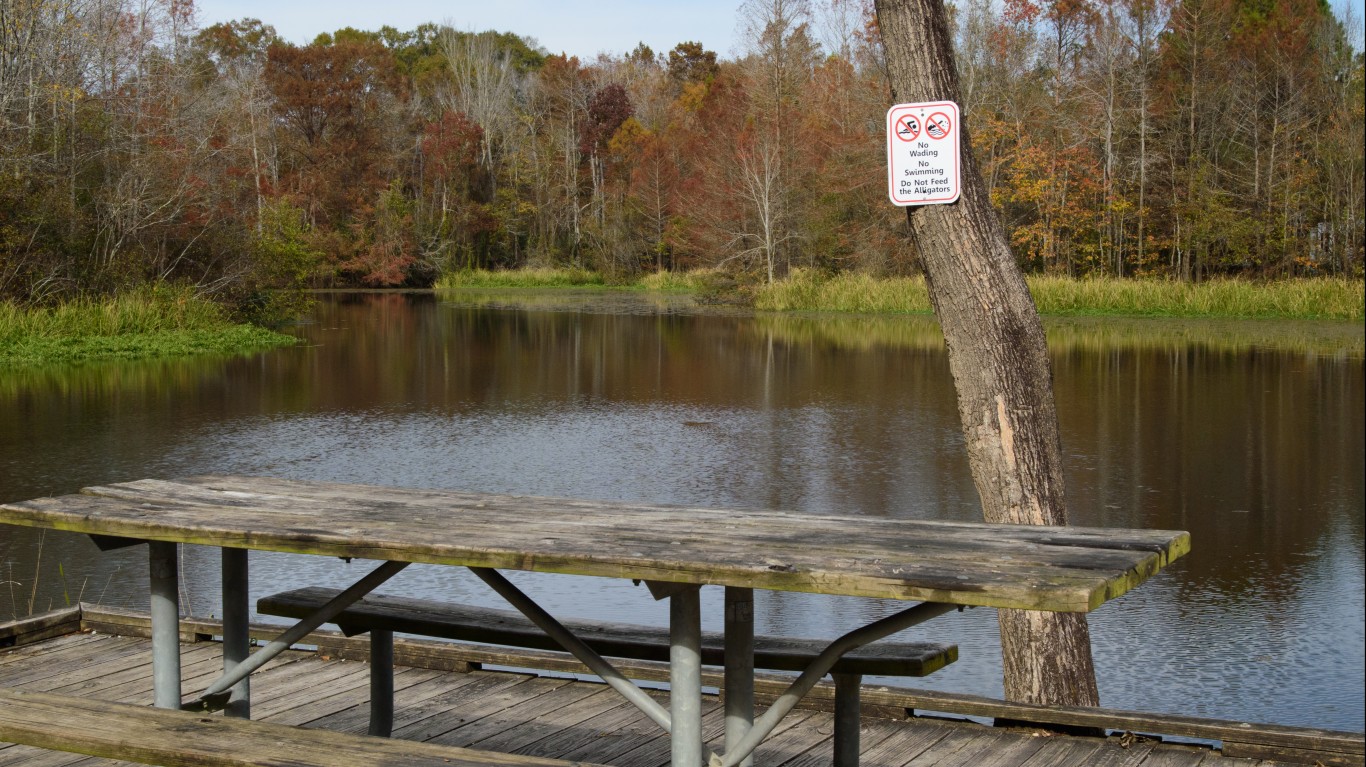
Louisiana: Washington Parish
> Annual drug deaths per 100,000 residents, 2015-2019: 70 (state: 24)
> Total drug-related deaths, 2015-2019: 163 — 10th most out of 64 counties (state: 5,577)
> Poverty rate: 24.4% — 18th highest out of 64 counties (state: 19.2%)
> Washington Parish population: 46,435
An average of 70 Washington Parish, Louisiana, residents per 100,000 people died from a drug overdose every year between 2015 and 2019. This is the highest overdose death rate in the state and the 12th highest of all 3,142 counties in the U.S. Fatal drug overdoses are a main driver of premature deaths across the country. In Washington Parish, the premature death rate is 643 deaths before age 75 per 100,000 people, the second highest in the state and nearly double the national rate of 340 per 100,000.
Drug use can have a wide range of long-term health effects, including respiratory problems and heart disease. In Washington Parish, more than one in four adults report being in poor or fair health, one of the highest rates in all of Louisiana.

Maine: Washington County
> Annual drug deaths per 100,000 residents, 2015-2019: 43 (state: 28)
> Total drug-related deaths, 2015-2019: 67 — 7th most out of 16 counties (state: 1,845)
> Poverty rate: 18.9% — 2nd highest out of 16 counties (state: 11.8%)
> Washington County population: 31,491
Washington County’s drug overdose death rate is 43 per 100,000 people a year, the highest of all 16 counties in Maine. Many people with drug use disorder are also diagnosed with other mental disorders. The opposite is also true. Regular use of some drugs can lead to mental health issues such as depression and anxiety. More than 14% of adults in the county report more than two weeks a month of poor mental health, the highest share in Maine.
Drug overdose deaths tend to be more common in poorer regions. Washington County has the second highest poverty rate in Maine, at 18.9%, and the third lowest median annual household income, at $41,347. The statewide figures are 11.8% and $57,918, respectively.
[in-text-ad-2]

Maryland: Baltimore city
> Annual drug deaths per 100,000 residents, 2015-2019: 93 (state: 35)
> Total drug-related deaths, 2015-2019: 2,846 — the most out of 24 counties (state: 10,511)
> Poverty rate: 21.2% — 2nd highest out of 24 counties (state: 9.2%)
> Baltimore city population: 609,032
Though rural areas have, at least in recent years, struggled with widespread drug problems, nowhere in Maryland has reported more drug overdose deaths than the city of Baltimore. Baltimore is an independent city and is not part of a larger county.
The city has the second highest rate of drug overdose deaths of any county or equivalent in the entire country, with more than 93 deaths per 100,000 residents. This is much higher than the U.S. rate of 21 deaths per 100,000.

Massachusetts: Bristol County
> Annual drug deaths per 100,000 residents, 2015-2019: 47 (state: 33)
> Total drug-related deaths, 2015-2019: 1,320 — 4th most out of 14 counties (state: 11,256)
> Poverty rate: 11.3% — 4th highest out of 14 counties (state: 10.3%)
> Bristol County population: 561,037
Bristol County, Massachusetts, which contains New Bedford, has the highest drug overdose death rate of any of the 14 counties in Massachusetts. Overdose death rates have increased significantly over the last two decades, particularly among the least educated population. People with lower educational attainment tend to earn lower incomes than workers with college degrees. In Briston County, 28.7% of adult residents have at least a bachelor’s degree, one of the lowest rates in the state.
Many people with a drug use disorder are often also diagnosed with other mental disorders, and vice versa. About 12.4% of adults in Bristol County report at least 14 days a month of poor mental health, one of the highest shares in the state.
[in-text-ad]

Michigan: Wayne County
> Annual drug deaths per 100,000 residents, 2015-2019: 43 (state: 27)
> Total drug-related deaths, 2015-2019: 3,773 — the most out of 83 counties (state: 13,456)
> Poverty rate: 22.3% — 3rd highest out of 83 counties (state: 14.4%)
> Wayne County population: 1,757,299
Wayne County, which contains Detroit and the surrounding area, has the biggest drug problem of anywhere in Michigan. The area reported 43 annual drug deaths per 100,000 residents from 2015 to 2019, more than double the U.S. rate.
Many areas with a high rate of drug deaths often also tend to struggle economically, and Wayne County is no exception. It has the highest share of households in Michigan living on less than $10,000 per year, at 11.2%, and 22.3% of residents live in poverty compared to a state poverty rate of 14.4%.
Minnesota: Mille Lacs County
> Annual drug deaths per 100,000 residents, 2015-2019: 31 (state: 14)
> Total drug-related deaths, 2015-2019: 40 — 16th most out of 87 counties (state: 3,850)
> Poverty rate: 12.4% — 19th highest out of 87 counties (state: 9.7%)
> Mille Lacs County population: 25,865
Between 2015 and 2019, there were an average of 31 drug overdose deaths per 100,000 people annually in Mille Lacs County, more than in any of the 87 counties in Minnesota. Overdose deaths have increased among people with the least education. Just 14.7% of Mille Lacs have at least a bachelor’s degree, the third lowest share in the state.
Drug overdoses are among the leading causes of death in the U.S. Mille Lacs County has the sixth highest premature death rate in Minnesota at 394 deaths before age 75 per 100,000 residents.
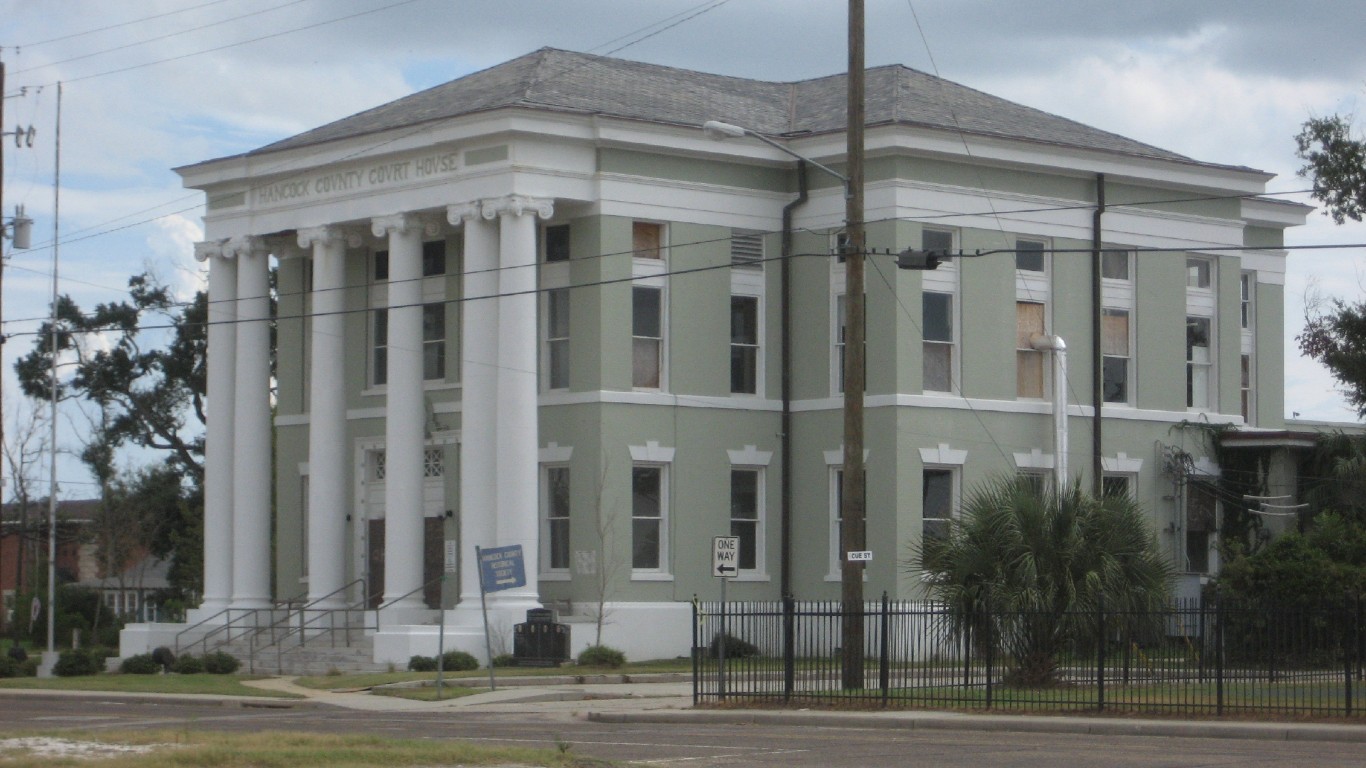
Mississippi: Hancock County
> Annual drug deaths per 100,000 residents, 2015-2019: 32 (state: 13)
> Total drug-related deaths, 2015-2019: 75 — 7th most out of 82 counties (state: 1,895)
> Poverty rate: 18.5% — 64th highest out of 82 counties (state: 20.3%)
> Hancock County population: 46,961
Of the 82 counties in Mississippi, Hancock had the highest rate of fatal drug overdoses at an average of 32 deaths per 100,000 residents a year between 2015 and 2019. The opioid crisis has hit lower-income areas the hardest. Though Hancock County is relatively well off compared to other counties in Mississippi, the state as a whole is the poorest of U.S. states.
For example, the median household income in Hancock County of $48,119 is more than the state median of $45,081 but significantly less than the national figure of $62,843. Similarly, 18.5% of county residents live below the poverty line — lower than the state poverty rate of 20.3% but significantly higher than the national rate of 13.4%.
[in-text-ad-2]

Missouri: St. Louis city
> Annual drug deaths per 100,000 residents, 2015-2019: 65 (state: 24)
> Total drug-related deaths, 2015-2019: 1,003 — 2nd most out of 115 counties (state: 7,251)
> Poverty rate: 21.8% — 19th highest out of 115 counties (state: 13.7%)
> St. Louis city population: 308,174
St. Louis is an independent city, not part of a county. Only 15 counties or equivalent geographic areas in the country have reported more annual drug deaths per capita in recent years than St. Louis City. The area, on the eastern edge of Missouri, reported 65 annual drug deaths per 100,000 residents from 2015 to 2019, by far the most in the state.
Areas that struggle with drug use also tend to struggle with poverty, and St. Louis is no exception. The city has a poverty rate of 21.8%, much higher than the 13.7% poverty rate in Missouri. In the city, 11.5% of households live on less than $10,000, nearly double the 6.2% statewide rate.

Montana: Silver Bow County
> Annual drug deaths per 100,000 residents, 2015-2019: 22 (state: 14)
> Total drug-related deaths, 2015-2019: 38 — 7th most out of 56 counties (state: 711)
> Poverty rate: 17.4% — 11th highest out of 56 counties (state: 13.1%)
> Silver Bow County population: 34,770
Montana has one of the lowest drug overdose deaths in the U.S., at 13 per 100,000 people compared to 21 per 100,000 across the country as a whole. The state’s Silver Bow County reported the highest number of overdose fatalities a year per 100,000 residents between 2015 and 2019, at 22 deaths per 100,000 people.
Drug overdoses continue to disproportionately affect those living in poverty. The Silver Bow County’s poverty rate of 17.4% is the 11th highest in the state and significantly higher than the state’s poverty rate of 13.1%. Additionally, 10.2% of households live on less than $10,000 a year, one of the largest shares in Montana and much higher than the state share of 6.0%.
[in-text-ad]

Nebraska: Scotts Bluff County
> Annual drug deaths per 100,000 residents, 2015-2019: 18 (state: 8)
> Total drug-related deaths, 2015-2019: 32 — 4th most out of 93 counties (state: 799)
> Poverty rate: 13.6% — 13th highest out of 93 counties (state: 11.1%)
> Scotts Bluff County population: 36,074
Nebraska reported the fewest annual drug deaths from 2015 to 2019 of any state, at 8.3 deaths per 100,000 residents. Even Scotts Bluff County, which had the highest rate of drug deaths per capita in the state, at 18 per 100,000, still had a lower rate than the U.S. overall, at 21 per 100,000.
Scotts Bluff County makes up part of the western edge of Nebraska, along the state’s border with Wyoming. Like many other counties that have the worst drug problem in their state, economic conditions in Scotts Bluff County are worse than they are across the state as a whole. The county’s median household income of $49,745 is well below the state median of $61,439. Though the county’s poverty rate of 13.6% is roughly in line with the national rate, it is higher than Nebraska’s 11.1% poverty rate.

Nevada: Nye County
> Annual drug deaths per 100,000 residents, 2015-2019: 36 (state: 23)
> Total drug-related deaths, 2015-2019: 80 — 4th most out of 17 counties (state: 3,407)
> Poverty rate: 16.4% — 2nd highest out of 17 counties (state: 13.1%)
> Nye County population: 44,380
At more than 18,000 square miles, Nye County, Nevada, is one of the largest in the U.S. by landmass. It makes up a large share of the southern and central part of the state. The county reported 36 annual drug deaths per 100,000 residents from 2015 to 2019, about 50% higher than the state rate.
In part because of the relative prevalence of drug deaths, Nye County residents are much more likely to die prematurely than the typical American county. The county reported 551 deaths before age 75 per 100,000 residents. The nationwide premature death rate is 340 incidents per 100,000.

New Hampshire: Hillsborough County
> Annual drug deaths per 100,000 residents, 2015-2019: 43 (state: 34)
> Total drug-related deaths, 2015-2019: 874 — the most out of 10 counties (state: 2,299)
> Poverty rate: 7.8% — 8th highest out of 10 counties (state: 7.6%)
> Hillsborough County population: 413,035
Hillsborough County, New Hampshire, residents are more than twice as likely to die of a drug overdose as a typical American. The county, in the southeastern part of the state, reported 43 annual drug deaths from 2015 to 2019 per 100,000 residents.
In recent years, rural areas have struggled more than urban ones with drug overdose deaths. Yet Hillsborough County stands out as having the biggest drug problem in New Hampshire despite being the most populous place in the state. With over 400,000 people, the county is more than 100,000 people larger than anywhere else in the state. It is home to Manchester and Nashua, the two largest cities in the state.
[in-text-ad-2]

New Jersey: Camden County
> Annual drug deaths per 100,000 residents, 2015-2019: 49 (state: 27)
> Total drug-related deaths, 2015-2019: 1,241 — 2nd most out of 21 counties (state: 12,237)
> Poverty rate: 12.2% — 7th highest out of 21 counties (state: 10.0%)
> Camden County population: 506,738
The annual drug deaths rate per capita in Camden County is the highest in New Jersey but also among the highest in the U.S. as a whole. Between 2015 and 2019, there have been an average of 49 drug deaths per 100,000 residents annually, more than double the national rate of 21 per 100,000 people.
Poor counties have been most affected by the opioid crisis. At 10.5%, Camden County’s November 2020 unemployment rate is the sixth highest in the state and significantly higher than the U.S. unemployment rate of 6.4%. Camden residents are also more likely to live below the poverty line compared to people across New Jersey as a whole.

New Mexico: Rio Arriba County
> Annual drug deaths per 100,000 residents, 2015-2019: 80 (state: 26)
> Total drug-related deaths, 2015-2019: 157 — 4th most out of 33 counties (state: 2,750)
> Poverty rate: 24.0% — 10th highest out of 33 counties (state: 19.1%)
> Rio Arriba County population: 39,159
Rio Arriba County reported 80 annual drug deaths per 100,000 residents from 2015 to 2019 — the fourth highest rate of any county or equivalent area in America and more than triple the annual drug deaths per 100,000 residents across New Mexico as a whole.
Much of Rio Arriba County in the northern part of New Mexico is made up of the Jicarilla Apache Nation Reservation. A study from The American Journal of Drug and Alcohol Abuse found that Native Americans were at three times as likely as the general population to die of a drug overdose.
[in-text-ad]

New York: Sullivan County
> Annual drug deaths per 100,000 residents, 2015-2019: 37 (state: 19)
> Total drug-related deaths, 2015-2019: 140 — 22nd most out of 62 counties (state: 18,738)
> Poverty rate: 15.2% — 17th highest out of 62 counties (state: 14.1%)
> Sullivan County population: 75,116
Sullivan County’s drug overdose death rate is 37 per 100,000 residents, the highest in New York state and nearly double the state rate of 19 drug overdose deaths per 100,000. Drug use can have a wide range of long-term health effects, including respiratory problems and heart disease. About 17.1% of Sullivan County adult residents report being in poor or fair health, the eighth highest share of all 62 counties in the state.
Accidental drug overdose is currently among the leading causes of preventable death in the U.S. The premature death rate in Sullivan County, which is located in southern New York bordering Pennsylvania, is 384 deaths before the age of 75 per 100,000 residents, the third highest in the state.
North Carolina: Jones County
> Annual drug deaths per 100,000 residents, 2015-2019: 43 (state: 21)
> Total drug-related deaths, 2015-2019: 21 — 78th most out of 100 counties (state: 10,909)
> Poverty rate: 24.5% — 6th highest out of 100 counties (state: 14.7%)
> Jones County population: 9,594
The rate of annual drug deaths in Jones County, North Carolina, is more than double the statewide and nationwide rates, which both stand at 21 overdose deaths per 100,000 residents. It is the only county in the state with more than 40 annual drug deaths per 100,000 in recent years.
Researchers have found that drug overdoses tend to cluster in lower-income areas, such as Jones County, near the state’s east coast. The county has a median annual household income of roughly $38,000 — well below the state median of $54,602. Similarly, while in North Carolina 14.7% of residents live in poverty, in Jones County, nearly a quarter of residents do.

North Dakota: Williams County
> Annual drug deaths per 100,000 residents, 2015-2019: 15 (state: 10)
> Total drug-related deaths, 2015-2019: 27 — 5th most out of 53 counties (state: 395)
> Poverty rate: 6.1% — 48th highest out of 53 counties (state: 10.7%)
> Williams County population: 35,208
Of the six North Dakota counties reporting drug overdose deaths, Williams County has the highest rate. There have been an average of 15 fatal drug overdoses a year per 100,000 residents between 2015 and 2019 in the county, compared to the state rate of 10 deaths per 100,000. As a whole, North Dakota has the third lowest overdose drug death rate in the U.S. — though just six of 53 counties reported drug data.
According to the CDC, more than half of people who misuse prescription drugs also binge drink, which is defined as consuming five or more drinks for men and four or more drinks for women in a span of two hours. William County has the highest binge drinking rate in North Dakota and one of the highest in the country, at 26.3%. The state and national rates are 24.1% and 19.0%, respectively.
[in-text-ad-2]
Ohio: Scioto County
> Annual drug deaths per 100,000 residents, 2015-2019: 70 (state: 37)
> Total drug-related deaths, 2015-2019: 267 — 17th most out of 88 counties (state: 21,787)
> Poverty rate: 22.6% — 2nd highest out of 88 counties (state: 14.0%)
> Scioto County population: 76,040
Between 2015 and 2019, Scioto County has reported a total of 267 fatal drug overdoses, or about 70 deaths per 100,000, the highest rate of all 88 counties in Ohio. Many people who have a drug use disorder are often also diagnosed with other mental disorders, and vice versa. Adults in the county report more than five mentally unhealthy days a month, more than in any other county in the state.
Drug use can have a wide range of long-term health effects, including respiratory problems and heart disease. In Scioto County, 23.2% of adults report being in poor or fair health, the second highest share in Ohio and significantly higher than the state share of 18.0%.

Oklahoma: Johnston County
> Annual drug deaths per 100,000 residents, 2015-2019: 38 (state: 19)
> Total drug-related deaths, 2015-2019: 21 — 41st most out of 77 counties (state: 3,815)
> Poverty rate: 20.9% — 12th highest out of 77 counties (state: 15.7%)
> Johnston County population: 11,064
With an average of 38 drug overdose deaths a year per 100,000 residents, Oklahoma’s Johnston County has the highest overdose mortality rate in the state. The county shares similar socioeconomic characteristics with counties in other states with the highest drug overdose death rate, including some of the highest poverty and unemployment rates of all 77 counties in the state
Accidental drug overdoses are among the leading causes of preventable death in the U.S. The premature death rate in Johnston County is one of the highest in Oklahoma, at 597 deaths before the age of 75 per 100,000 residents.
[in-text-ad]

Oregon: Curry County
> Annual drug deaths per 100,000 residents, 2015-2019: 26 (state: 16)
> Total drug-related deaths, 2015-2019: 30 — 20th most out of 36 counties (state: 3,375)
> Poverty rate: 12.4% — 25th highest out of 36 counties (state: 13.2%)
> Curry County population: 22,650
Curry County, Oregon, is a small county with a population of about 23,000. Though there have been a total of 30 fatal drug overdoses in the county between 2015 and 2019, due to the county’s small population, the drug overdose death rate amounts to 26 per 100,000, the highest in the state.
Poorer counties have been disproportionately affected by the opioid crisis. At 6.1%, the unemployment rate of Curry County is one of the highest in Oregon. The median household income in the county of $48,440 a year is one of the lowest in the state and significantly lower than the state median of $62,818 a year.

Pennsylvania: Philadelphia County
> Annual drug deaths per 100,000 residents, 2015-2019: 56 (state: 35)
> Total drug-related deaths, 2015-2019: 4,376 — the most out of 67 counties (state: 22,643)
> Poverty rate: 24.3% — the highest out of 67 counties (state: 12.4%)
> Philadelphia County population: 1,579,075
Philadelphia County, which includes the city of Philadelphia and other surrounding parts of southeastern Pennsylvania, has the most severe drug problem in the state. The county of nearly 1.6 million people reported 56 annual drug deaths per 100,000 between 2015 and 2019.
Pennsylvania has the third worst drug problem among states, behind only Ohio and West Virginia, with 35 annual drug deaths per 100,000 residents, compared to 21 deaths per 100,000 nationwide. Of the 62 counties for which there is data in Pennsylvania, 49 have an annual drug death rate higher than the national rate. Of the 100 counties in America with the highest average fatal drug overdose rate from 2015 to 2019, 13 are in Pennsylvania.
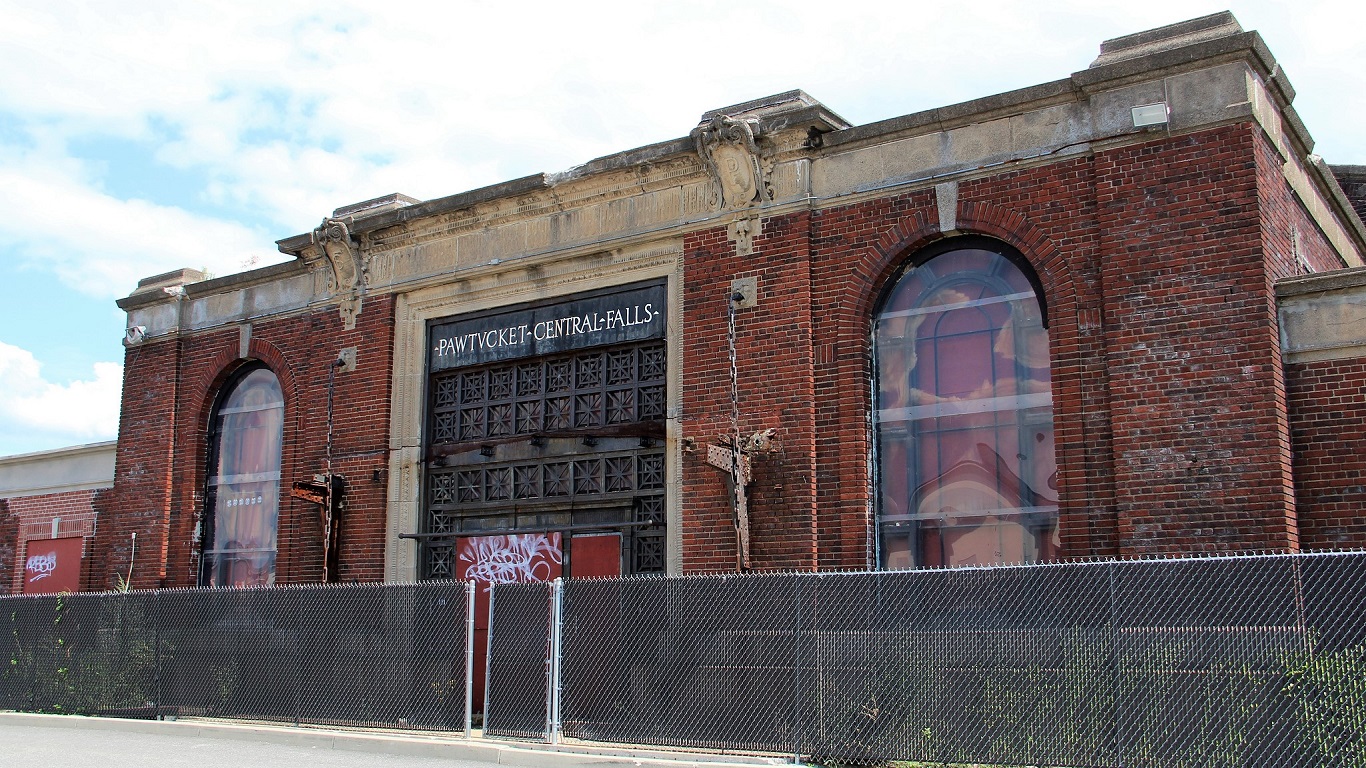
Rhode Island: Providence County
> Annual drug deaths per 100,000 residents, 2015-2019: 34 (state: 30)
> Total drug-related deaths, 2015-2019: 1,067 — the most out of 5 counties (state: 1,610)
> Poverty rate: 15.2% — the highest out of 5 counties (state: 12.4%)
> Providence County population: 635,737
Of the five counties in Rhode Island, Providence, which is also the most populous, has the highest drug overdose death rate in the state at 34 per 100,000 people. Providence is also the county with the highest share of adults who report being in poor or fair health, at 17.3%, compared to the state’s overall share of 16.4%.
Among the hardest-hit areas by the opioid crisis are those with low socioeconomic status. The median household income in Providence County is significantly lower than in all other four counties in Rhode Island, at $58,974 a year.
[in-text-ad-2]
South Carolina: Horry County
> Annual drug deaths per 100,000 residents, 2015-2019: 32 (state: 20)
> Total drug-related deaths, 2015-2019: 532 — 2nd most out of 46 counties (state: 5,148)
> Poverty rate: 15.0% — 34th highest out of 46 counties (state: 15.2%)
> Horry County population: 332,172
Between 2015 and 2019, the average number of fatal drug overdoses in Horry County was 32 deaths per 100,000 residents, the highest rate of all 46 counties in South Carolina. More than half of people who are addicted to prescription drugs also binge drink, which is defined as consuming five or more drinks for men and four or more drinks for women in a span of two hours, according to the CDC. In Horry County, 17.7% of adults report binge drinking, one of the highest shares in the state.
Horry County shares similar socioeconomic characteristics with other counties with the highest drug overdose death rate in their state, including significantly higher poverty rate and much lower annual household income than the state as a whole.
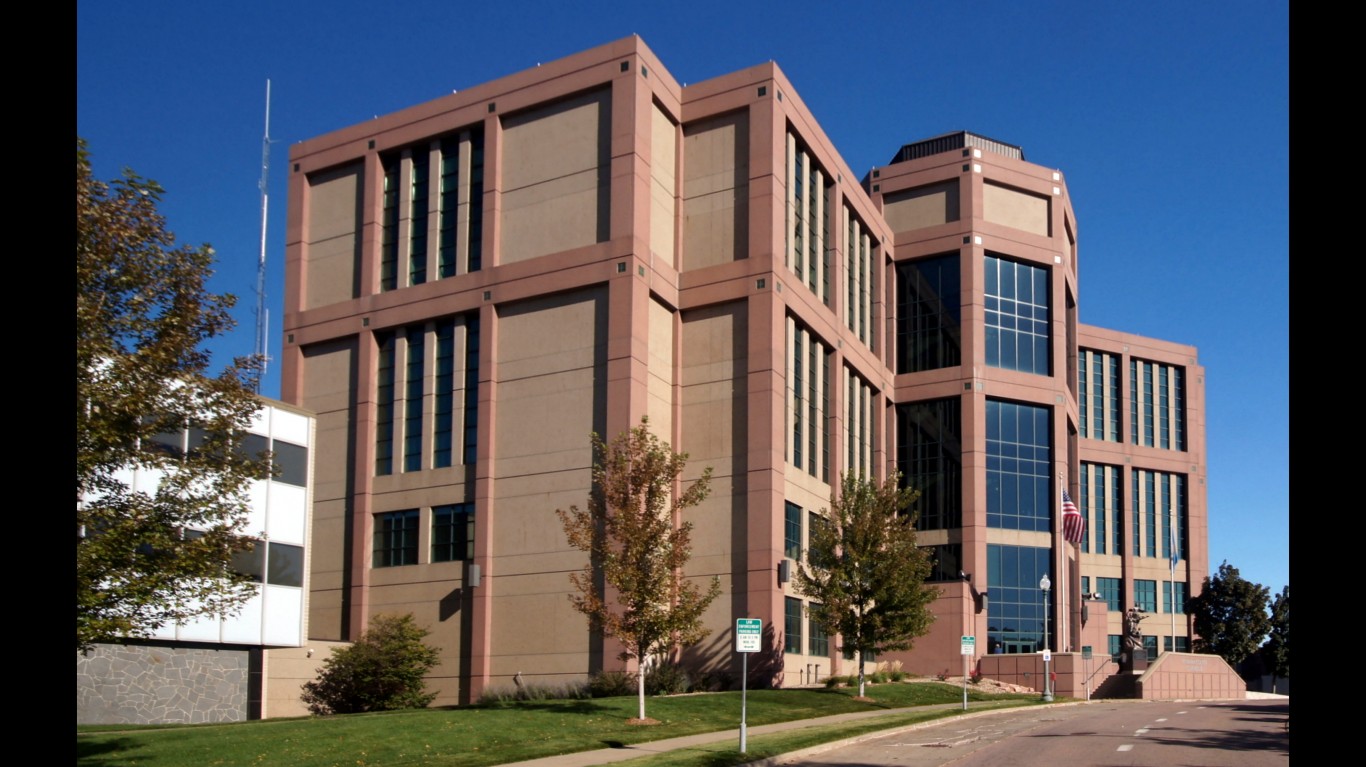
South Dakota: Minnehaha County
> Annual drug deaths per 100,000 residents, 2015-2019: 12 (state: 9)
> Total drug-related deaths, 2015-2019: 116 — the most out of 66 counties (state: 377)
> Poverty rate: 10.0% — 39th highest out of 66 counties (state: 13.1%)
> Minnehaha County population: 188,674
South Dakota has the second lowest rate of annual drug deaths of U.S. states, reporting fewer than nine deaths per 100,000 residents from 2015 to 2019 — though just two of 66 counties have data. Even in the South Dakota county with the biggest drug problem, Minnehaha County, drug overdose deaths are much less common than nationwide, at 12 overdose deaths per 100,000. Nationwide, there were 21 annual drug deaths annually per 100,000 from 2015 to 2019.
Overall, Minnehaha County residents tend to be very healthy. The area’s residents reported low average numbers of mentally and physically unhealthy days. Just 11.6% of adults in Minnehaha County reported being in either fair or poor health, compared to 17.2% of all American adults.
[in-text-ad]

Tennessee: Cheatham County
> Annual drug deaths per 100,000 residents, 2015-2019: 54 (state: 28)
> Total drug-related deaths, 2015-2019: 109 — 17th most out of 95 counties (state: 9,353)
> Poverty rate: 10.6% — 89th highest out of 95 counties (state: 15.2%)
> Cheatham County population: 40,181
Of the 95 counties in Tennessee, Cheatham, which is located in Middle Tennessee, has the highest rate of overdose deaths in the state. Between 2015 and 2019, an average of 54 per 100,000 people died from drug overdose a year, nearly double the state’s rate.
Cheatham County is an example of a comparatively wealthier region in the state having the highest overdose death rate. The annual household income in the county is $61,913 a year compared to the state median of $53,320, and the poverty rate is 10.6%, one of the lowest rates and compared to 15.2% across the state.

Texas: Tyler County
> Annual drug deaths per 100,000 residents, 2015-2019: 23 (state: 11)
> Total drug-related deaths, 2015-2019: 25 — 68th most out of 254 counties (state: 15,335)
> Poverty rate: 16.5% — 94th highest out of 254 counties (state: 14.7%)
> Tyler County population: 21,518
Drug overdose deaths are fairly uncommon in Texas, with the state reporting just 11 annual drug deaths per 100,000 residents from 2015 to 2019. Tyler County, northeast of Houston near the Louisiana border, has the state’s higher rate of annual drug deaths, at 23 per 100,000, which is only slightly higher than the nationwide rate of 21 deaths per 100,000 people.
Like many other counties that have the biggest drug problem in their state, Tyler County residents are more likely to struggle economically than other Texans. The area has a 16.5% poverty rate, compared to the state’s 14.7% poverty rate. It also has a median annual household income under $44,500, compared to the statewide median of $61,874.

Utah: Carbon County
> Annual drug deaths per 100,000 residents, 2015-2019: 45 (state: 21)
> Total drug-related deaths, 2015-2019: 46 — 10th most out of 29 counties (state: 3,333)
> Poverty rate: 16.8% — 4th highest out of 29 counties (state: 9.8%)
> Carbon County population: 20,308
There have been an average of 45 deaths from drug overdose a year per 100,000 people in Carbon County, the highest rate in Utah and more than double the national rate. Many people who have drug use disorder are also diagnosed with other mental disorders, and vice versa. In Carbon, 12.9% of adults report 14 or more days of poor mental health, the third highest share of all 29 counties in Utah, though nearly in line with the national share of 12.4%.
Carbon County shares similar socioeconomic characteristics with other counties with the highest drug overdose death rate in their state, including a poverty rate that is about double the state poverty rate and a share of households earning less than $10,000 a year that is also about double the state share.
[in-text-ad-2]

Vermont: Windham County
> Annual drug deaths per 100,000 residents, 2015-2019: 38 (state: 22)
> Total drug-related deaths, 2015-2019: 81 — 2nd most out of 14 counties (state: 690)
> Poverty rate: 13.7% — the highest out of 14 counties (state: 10.9%)
> Windham County population: 42,823
Windham County’s drug overdose death rate of 38 per 100,000 residents is the highest in Vermont and significantly higher than the drug overdose death rates in the other 14 counties in the state.
Poorer counties have been disproportionately affected by the opioid crisis. At 13.7%, Windham County’s poverty rate is the highest in Vermont and higher than the state rate of 10.9%. Similarly, the median household income is $51,985 a year, one of the lowest in the state and about $10,000 less than the state’s median of $61,973 a year.
Virginia: Hopewell city
> Annual drug deaths per 100,000 residents, 2015-2019: 42 (state: 17)
> Total drug-related deaths, 2015-2019: 47 — 37th most out of 133 counties (state: 7,195)
> Poverty rate: 23.6% — 15th highest out of 133 counties (state: 10.6%)
> Hopewell city population: 22,456
Virginia has nearly 100 counties, as well as dozens of independent cities outside of county jurisdictions. Hopewell city, which is about 20 miles south of Richmond along the James River, has the worst drug problem in the state, with 42 annual drug deaths per 100,000 residents. Throughout Virginia as a whole, drug deaths are less than half as common, at 17 deaths per 100,000 residents.
Virginia is a relatively economically prosperous state, with one of the highest median household incomes at $74,222 and one of the lowest poverty rates of 10.6%. Yet Hopewell, like many other areas with relatively severe drug problems, struggles economically. The city has a poverty rate of 23.6% and a median household income of just over $39,000. Hopewell has one of the highest unemployment rates of any part of the U.S., at 8.5%.
[in-text-ad]

Washington: Grays Harbor County
> Annual drug deaths per 100,000 residents, 2015-2019: 28 (state: 17)
> Total drug-related deaths, 2015-2019: 101 — 13th most out of 39 counties (state: 6,445)
> Poverty rate: 14.4% — 12th highest out of 39 counties (state: 10.8%)
> Grays Harbor County population: 72,779
Grays Harbor County makes up the center of Washington’s western coast along the Pacific Ocean. The area has the highest rate of annual drug deaths, at 28 per 100,000 residents. It is one of six out of Washington’s 39 counties with a higher rate of annual drug death than the overall U.S. rate of 21 per 100,000.
Like many other areas with relatively severe drug problems, Grays Harbor County performs relatively poorly in many economic indicators. The county had an unemployment rate of 9.6% in November 2020, one of the highest in the country. It also has a median household income of $51,240, well below the state median of $73,775.

West Virginia: Cabell County
> Annual drug deaths per 100,000 residents, 2015-2019: 120 (state: 50)
> Total drug-related deaths, 2015-2019: 568 — 2nd most out of 55 counties (state: 4,545)
> Poverty rate: 22.3% — 10th highest out of 55 counties (state: 17.6%)
> Cabell County population: 94,339
Cabell County, located in the western part of West Virginia, near the intersection of the state’s borders with Ohio and Kentucky, has by far the worst drug problem of anywhere in America. From 2015 to 2019, the area had 120 annual drug deaths per 100,000 residents, nearly six times the national rate. The next highest county or county equivalent reported 83 drug deaths per 100,000 people.
West Virginia has often been described as the center of America’s opioid epidemic. It is home to 12 out of the 25 counties with the highest rates of annual drug deaths in recent years.

Wisconsin: Milwaukee County
> Annual drug deaths per 100,000 residents, 2015-2019: 36 (state: 19)
> Total drug-related deaths, 2015-2019: 1,713 — the most out of 72 counties (state: 5,536)
> Poverty rate: 19.0% — 2nd highest out of 72 counties (state: 11.3%)
> Milwaukee County population: 951,226
Milwaukee County, which includes the city of Milwaukee, has a drug overdose death rate of 36 per 100,000 people, the highest of all 72 counties in Wisconsin. The county has the second highest share of adults reporting being in poor or fair health, at 18.4%, compared to a state share of 16.7%. Drug use can have a wide range of long-term health effects, including respiratory problems and heart disease. The state also has the second highest share of adults reporting at least two weeks a month of poor mental health, at 13.4%. Many people with a drug use disorder are often also diagnosed with other mental disorders, including depression and anxiety.
Similar to other counties with the highest drug overdose death rate in their state, Milwaukee County has a higher poverty rate than Wisconsin as a whole. About 19.0% of residents live below the poverty line, the second highest poverty rate in the state.
[in-text-ad-2]

Wyoming: Carbon County
> Annual drug deaths per 100,000 residents, 2015-2019: 29 (state: 15)
> Total drug-related deaths, 2015-2019: 22 — 6th most out of 23 counties (state: 422)
> Poverty rate: 12.4% — 8th highest out of 23 counties (state: 11.0%)
> Carbon County population: 15,247
Between 2015 and 2019, there were an average of 29 deaths a year from drug overdose per 100,000 people in Carbon County, the highest rate in Wyoming. Accidental drug overdose is currently among the leading causes of preventable death in the U.S., and the county’s premature death rate of 409 deaths before the age of 75 per 100,000 residents is among the highest in the state.
About 15.7% of adult residents in Carbon County report being in poor or fair health, the third highest share in Wyoming. Drug use can have a wide range of long-term health effects, including respiratory problems and heart disease.
The thought of burdening your family with a financial disaster is most Americans’ nightmare. However, recent studies show that over 100 million Americans still don’t have proper life insurance in the event they pass away.
Life insurance can bring peace of mind – ensuring your loved ones are safeguarded against unforeseen expenses and debts. With premiums often lower than expected and a variety of plans tailored to different life stages and health conditions, securing a policy is more accessible than ever.
A quick, no-obligation quote can provide valuable insight into what’s available and what might best suit your family’s needs. Life insurance is a simple step you can take today to help secure peace of mind for your loved ones tomorrow.
Click here to learn how to get a quote in just a few minutes.
Thank you for reading! Have some feedback for us?
Contact the 24/7 Wall St. editorial team.